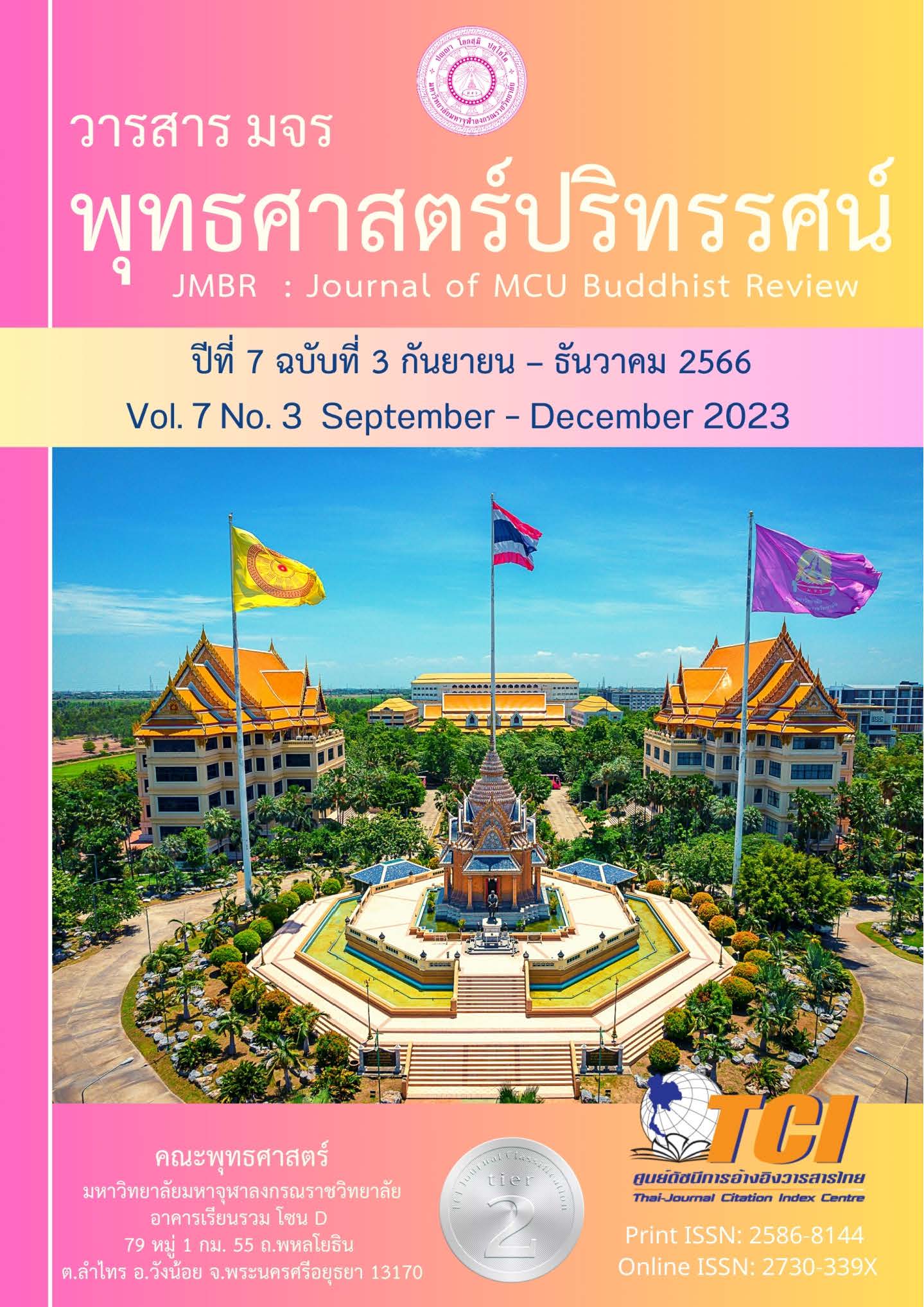สัมมาวาจา: พุทธบูรณาการเพื่อการสื่อสารเชิงพหุวัฒนธรรม
Main Article Content
บทคัดย่อ
งานวิจัยนี้มีวัตถุประสงค์ 1) เพื่อศึกษาหลักการ แนวคิด ทฤษฎีการสื่อสารเชิงพหุวัฒนธรรม 2) เพื่อศึกษาหลักสัมมาวาจาเพื่อการสื่อสารในมุมมองพระพุทธศาสนา 3) เพื่อนำเสนอพุทธบูรณาการหลักสัมมาวาจาเพื่อการสื่อสารเชิงพหุวัฒนธรรม การวิจัยนี้เป็นการวิจัยเชิงเอกสาร โดยวิเคราะห์ข้อมูลเนื้อหาและนำเสนอแนวทางการสื่อสารแบบบูรณาการเชิงพหุวัฒนธรรม
ผลการวิจัย พบว่า 1) หลักการ แนวคิด ทฤษฎีการสื่อสารเชิงพหุวัฒนธรรม ได้แก่ ต้องรู้จักเนื้อหาประเด็นอ่อนไหวที่จะนำไปสู่ความขัดแย้ง องค์ประกอบสื่อสาร ได้แก่ ผู้ส่งสาร เนื้อหาของสาร ช่องทางในการส่งสาร และผู้รับสาร การสื่อสารที่ดีต้องสะท้อนคุณค่า ทัศนคติ พฤติกรรม และวิถีชีวิตของสังคมที่ไม่ใช้ความรุนแรง สร้างการยอมรับในความแตกต่าง เคารพสิทธิ ยุติธรรมเท่าเทียม สร้างทัศนคติที่ดีต่อกัน ใช้เหตุและผล ป้องกันและขจัดการความขัดแย้ง ไม่คุกคาม ด้อยค่า และกีดกัน 2) หลักสัมมาวาจาเพื่อการสื่อสารในพระพุทธศาสนาเป็นไปเพื่อการขัดเกลาขจัดกิเลส สร้างกุศล เพื่อประโยชน์สุข ต้องสื่อสารด้วยความอดทนอดกลั้น ไม่เบียดเบียนทำร้าย ไม่กล่าวร้าย ไม่ทำร้าย มูลเหตุของความขัดแย้งมาจากความไม่รู้ ไม่เข้าใจกัน ตัณหา มานะ ทิฐิ ความโลภ ความโกรธ ความหลง ความอยากได้ อยากใหญ่ ใจแคบ มีความลำเอียง ดังนั้น การสื่อสารที่ดีควรอยู่ภายใต้กรอบ สัมมาวาจา วาจาสุภาษิต วจีสุจริต 4 ศีล 5 สาราณียธรรม 6 ฆราวาสธรรม อคติ 4 โดยรวมการสื่อสารจะมีลักษณะถูกกาล จริง อ่อนหวาน มีประโยชน์และสื่อสารด้วยเมตตา 3) พุทธบูรณาการหลักสัมมาวาจาเพื่อการสื่อสารเชิงพหุวัฒนธรรม พบว่า (1) การสื่อสารเพื่อการป้องกันความขัดแย้งต้องเรียนรู้และเข้าใจวัฒนธรรมของผู้อื่น เคารพให้เกียรติกัน เชิดชูคุณค่า สร้างสรรค์ รู้จักเหตุ รู้จักผล รู้จักสภาพตน รู้จักประมาณ รู้จักกาลเวลา รู้จักชุมชน รู้จักบุคคล (2) การสื่อสารเพื่อแก้ไขความขัดแย้ง ต้องยึดหลักความรัก ไมตรี โยนิโสมนสิการ คือ มุ่งรื้อฟื้นความสัมพันธ์ เปิดใจกว้างปราศจากอคติ ฟังอย่างมีสติและตั้งใจ ให้อภัย (3) การสื่อสารเพื่อการส่งเสริมพัฒนา ต้องสร้างการมีส่วนร่วม ความไว้เนื้อเชื่อใจ ความยุติธรรม สิทธิและเสรีภาพ ยอมรับความแตกต่าง ไม่กระตุ้นความโลภ ความโกรธ ความหลง (4) การสื่อสารเพื่อสนับสนุนรักษาสืบต่อ ต้องหมั่นประชุมพบปะหารือร่วมกัน ย้ำเตือนสติให้เห็นคุณและเห็นโทษ ประโยชน์และไม่ใช่ประโยชน์
Article Details

อนุญาตภายใต้เงื่อนไข Creative Commons Attribution-NonCommercial-NoDerivatives 4.0 International License.
- บทความที่ได้รับการตีพิมพ์เป็นลิขสิทธิ์ของวารสาร มจร พุทธศาสตร์ปริทรรศน์
- ข้อความใดๆ ที่ปรากฎในบทความที่ได้รับการตีพิมพ์ในวารสาร ถือเป็นความรับผิดชอบของผู้เขียนบทความ และข้อคิดเห็นนั้นไม่ถือว่าเป็นทัศนะและความรับผิดชอบของกองบรรณาธิการวารสาร มจร พุทธศาสตร์ปริทรรศน์
เอกสารอ้างอิง
ปฐมามาศ โชติบัณ. (2558). การสื่อสารอย่างสันติเพื่ออยู่ร่วมกันบนความหลากหลาย. วารสารเครือข่ายวิทยาลัยพยาบาลและกาสาธารณสุขภาคใต้. 2(1), 79-90.
พระธรรมปิฏก (ป.อ.ปยุตฺโต). (2553). พจนานุกรมพุทธศาสน์ฉบับประมวลศัพท์. กรุงเทพฯ: บริษัทสหธรรมิกจำกัด.
พระมหานภดล ปุญฺญสุวฑฺฒโก. (2560). การอยู่ร่วมกันของคนในสังคมพหุวัฒนธรรม: กรณีศึกษาชุมชนเขตบางรัก. รายงานการวิจัย. พระนครศรีอยุธยา: สถาบันวิจัยพุทธศาสตร์.
พัทธ์ธีรา นาคอุไรรัตน์ และซัมซู สาอุ. (2565). การสร้างสันติภาพที่ยั่งยืนในชุมชนพหุลักษณ:ชายแดนใต้บนฐานคิดสิทธิทางวัฒนธรรมและสุขภาวะองค์รวมเพื่อสันติภาพ. วารสารสันติศึกษาปริทรรศน์ มจร. 10(3), 954-960.
พิณจ์ทอง แมนสุมิตร์ชัย. (2560). รูปแบบการสื่อสารอย่างสันติเชิงพุทธจิตวิทยา. วารสารสันติศึกษาปริทรรศน์ มจร. 5(3), 76-77.
เพิ่มศักดิ์ มกราภิรมย์. สันติวัฒนธรรม. สืบค้น 20 กันยายน 2566 จาก http://www.peace.mahidol.ac.th/th/document/learn/PBPS101/Peace%20Culture.ppt.
แพมาลา วัฒนเสถียร. (2557). ปัจจัยที่ส่งผลต่อปัญหาการสื่อสารในองค์กร. บริหารธุรกิจมหาบัณฑิต สาขาเทคโนโลยีและสื่อสารการศึกษา บัณฑิตวิทยาลัย: มหาวิทยาลัยธรรมศาสตร์.
มหาจุฬาลงกรณราชวิทยาลัย. (2539). พระไตรปิฎกภาษาไทย ฉบับมหาจุฬาลงกรณราชวิทยาลัย. กรุงเทพฯ: มหาจุฬาลงกรณราชวิทยาลัย.
มาลีวัล เลิศสาครศิริ. (2559). ประสิทธิผลของโปรแกรมการฝึกสมาธิ ต่อพหุปัญญาของนักศึกษาชั้นปีที่ 1 วิทยาลัยเซนต์หลุยส์ วารสารพยาบาลทหารบก. Journal of The Royal Thai Army Nurses. 17 (13), 25-59.
วรากรณ์ สามโกเสส. (2566). ชูสังคมสันติวัฒนธรรม ทางออกประเทศไทย. สำนักข่าวอิสรา. สืบค้น 30 กันยายน 2566 จาก https://www.isranews.org/thaireform-news-conscious/12394-2010-12-08-13-26-25.html
ศศิรัศม์ วีระไวทยะ. (2554). การนาเสนอยุทธศาสตร์การสร้างเครือข่ายความร่วมมือเพื่อเสริมสร้างสันติวัฒนธรรม โดยใช้สถานศึกษาเป็นฐาน. วิทยานิพนธ์คุรุศาสตร์ดุษฎีบัณฑิต สาขาพัฒนาการศึกษา บัณฑิตวิทยาลัย: มหาวิทยาลัยจุฬาลงกรณ์ราชวิทยาลัย.
สมเด็จพระญาณสังวร สมเด็จพระสังฆราช. (2540). หลักพระพุทธศาสนา. กรุงเทพฯ: มหามกุฏราชวิทยาลัย.


